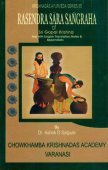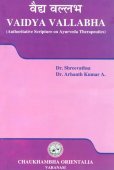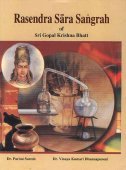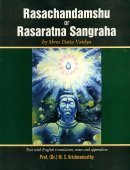Visphota, Visphoṭa: 17 definitions
Introduction:
Visphota means something in Buddhism, Pali, Hinduism, Sanskrit, Marathi, Hindi. If you want to know the exact meaning, history, etymology or English translation of this term then check out the descriptions on this page. Add your comment or reference to a book if you want to contribute to this summary article.
Alternative spellings of this word include Visfot.
In Hinduism
Ayurveda (science of life)
Kalpa (Formulas, Drug prescriptions and other Medicinal preparations)
Source: Shodhganga: Edition translation and critical study of yogasarasamgrahaVisphoṭa (विस्फोट) refers to “eruption” and is one of the various diseases mentioned in the 15th-century Yogasārasaṅgraha (Yogasara-saṅgraha) by Vāsudeva: an unpublished Keralite work representing an Ayurvedic compendium of medicinal recipes. The Yogasārasaṃgraha [mentioning visphoṭa] deals with entire recipes in the route of administration, and thus deals with the knowledge of pharmacy (bhaiṣajya-kalpanā) which is a branch of pharmacology (dravyaguṇa).
Unclassified Ayurveda definitions
Source: Wisdom Library: Āyurveda and botanyVisphoṭa (विस्फोट):—One of the eighteen types of Kuṣṭha (“skin disease”), according to the Caraka-saṃhitā (cikitsāsthāna), which is an important Sanskrit work dealing with Āyurveda. This condition of the skin (kuṣṭha) is caused by the corruption of the three doṣas (tridoṣa: vāta, pitta and kapha) which in turn corrupts the skin, blood, muscle and lymph. Visphoṭa-kuṣṭha is characterized by reddish or white pustules having thin walls. Visphoṭa is caused by a preponderance of Pitta-doṣa (‘bodily bile’) and Kapha-doṣa (‘bodily phlegm’). The literal translation of Visphoṭa is “an eruption” or “a boil”. It is also known as Visphoṭaka.
Source: Ancient Science of Life: Vaidyavallabha: An Authoritative Work on Ayurveda TherapeuticsVisphoṭa (विस्फोट) is mentioned as a disease that can be treated with metallic drugs including ingredients such as Haratālabhasma (calcified orpiment) and Tuttha (blue vitriol), as mentioned in the 17th-century Vaidyavallabha (chapter 3) written by Hastiruci.—The Vaidyavallabha is a work which deals with the treatment and useful for all 8 branches of Ayurveda. The text Vaidyavallabha (mentioning visphoṭa) has been designed based on the need of the period of the author, availability of drugs during that time, disease manifesting in that era, socio-economical-cultural-familial-spiritual-aspects of that period Vaidyavallabha.
Source: gurumukhi.ru: Ayurveda glossary of termsVisphoṭa (विस्फोट):—Blister

Āyurveda (आयुर्वेद, ayurveda) is a branch of Indian science dealing with medicine, herbalism, taxology, anatomy, surgery, alchemy and related topics. Traditional practice of Āyurveda in ancient India dates back to at least the first millenium BC. Literature is commonly written in Sanskrit using various poetic metres.
Shaivism (Shaiva philosophy)
Source: SOAS University of London: Protective Rites in the Netra TantraVisphoṭa (विस्फोट) or Visphoṭaka refers to “(insect) bites”, according to the Netratantra of Kṣemarāja: a Śaiva text from the 9th century in which Śiva (Bhairava) teaches Pārvatī topics such as metaphysics, cosmology, and soteriology.—Accordingly, [verse 19.121-128, while describing the prevention of natural disasters]—“[...] [He performs the ritual when people are afflicted by] skin diseases, etc., fevers, untimely death or various sorts of pain, past faults or seizing spirits. Diseases from snake poison, etc., insect bites, etc. (visphoṭa—kīṭavisphoṭakādayaḥ), rheumatism, change in form, phlegm, hemorrhoids, eye diseases, skin diseases, etc., internal disease, and sickness caused by wounds, etc., by the thousands [can occur] if various sorts of evils touch the Maṇḍala, a defect arises from offense [occurs]. [...]”.
Visphoṭa is mentioned in a list of afflictions (which does not arise in the place and time of the Mantravid), according to verse 19.129-133.

Shaiva (शैव, śaiva) or Shaivism (śaivism) represents a tradition of Hinduism worshiping Shiva as the supreme being. Closely related to Shaktism, Shaiva literature includes a range of scriptures, including Tantras, while the root of this tradition may be traced back to the ancient Vedas.
In Buddhism
Tibetan Buddhism (Vajrayana or tantric Buddhism)
Source: OSU Press: Cakrasamvara SamadhiVisphoṭa (विस्फोट) refers to a “crack”, according to the Guru Mandala Worship (maṇḍalārcana) ritual often performed in combination with the Cakrasaṃvara Samādhi, which refers to the primary pūjā and sādhanā practice of Newah Mahāyāna-Vajrayāna Buddhists in Nepal.—Accordingly, “Oṃ amṛta-kuṇḍalī kha kha khāhi khāhi tiṣṭha tiṣṭha bandha bandha Hana hana daha daha paca paca garja garja visphoṭaya visphoṭaya Sarva-vighna-vināyakānāṃ mahā-gaṇapati-jīvitāntakarāya Hūṃ hūṃ phaṭ phaṭ svāhā!”.

Tibetan Buddhism includes schools such as Nyingma, Kadampa, Kagyu and Gelug. Their primary canon of literature is divided in two broad categories: The Kangyur, which consists of Buddha’s words, and the Tengyur, which includes commentaries from various sources. Esotericism and tantra techniques (vajrayāna) are collected indepently.
Languages of India and abroad
Marathi-English dictionary
Source: DDSA: The Molesworth Marathi and English Dictionaryvisphōṭa (विस्फोट).—m S A boil, blain, or pustule.
Source: DDSA: The Aryabhusan school dictionary, Marathi-Englishvisphōṭa (विस्फोट).—m n Boil.
Marathi is an Indo-European language having over 70 million native speakers people in (predominantly) Maharashtra India. Marathi, like many other Indo-Aryan languages, evolved from early forms of Prakrit, which itself is a subset of Sanskrit, one of the most ancient languages of the world.
Sanskrit dictionary
Source: Cologne Digital Sanskrit Dictionaries: Shabda-Sagara Sanskrit-English DictionaryVisphoṭa (विस्फोट).—mf.
(-ṭaḥ-ṭā) 1. Boil, pustule. 2. Small-pox. E. vi before, sphuṭ to hurt or break, aff. ghañ or ṇic-ac .
Source: Cologne Digital Sanskrit Dictionaries: Benfey Sanskrit-English DictionaryVisphoṭa (विस्फोट).—i. e. vi-sphuṭ + a, m., and f. ṭā, 1. Boil, pustule, [Śākuntala, (ed. Böhtlingk.)] Sch. ad 20, 10. 2. Small-pox.
Source: Cologne Digital Sanskrit Dictionaries: Cappeller Sanskrit-English DictionaryVisphoṭa (विस्फोट).—[masculine] crackling; boil, pustule.
Source: Cologne Digital Sanskrit Dictionaries: Monier-Williams Sanskrit-English Dictionary1) Visphoṭa (विस्फोट):—[=vi-sphoṭa] [from vi-sphuṭ] a m. cracking, crashing, [Mahābhārata]
2) [v.s. ...] a blister, boil, [Kāvya literature; Kathāsaritsāgara; Suśruta]
3) [v.s. ...] mfn. open, [Divyāvadāna]
4) [=vi-sphoṭa] b etc. See above under vi-√sphuṭ.
Source: Cologne Digital Sanskrit Dictionaries: Yates Sanskrit-English DictionaryVisphoṭa (विस्फोट):—[vi-sphoṭa] (ṭaḥ-ṭā) 1. m. f. Boil, pustule; small-pox.
[Sanskrit to German]
Sanskrit, also spelled संस्कृतम् (saṃskṛtam), is an ancient language of India commonly seen as the grandmother of the Indo-European language family (even English!). Closely allied with Prakrit and Pali, Sanskrit is more exhaustive in both grammar and terms and has the most extensive collection of literature in the world, greatly surpassing its sister-languages Greek and Latin.
Hindi dictionary
Source: DDSA: A practical Hindi-English dictionaryVisphoṭa (विस्फोट) [Also spelled visfot]:—(nm) explosion, blast; burst; crack (ing); ~[ka/~kārī] explosive; a cracker; ~[ka padārtha] explosive substance; ~[na] explosion; —[honā] to explode, to crack; to blast, to burst.
...
Kannada-English dictionary
Source: Alar: Kannada-English corpusVisphōṭa (ವಿಸ್ಫೋಟ):—
1) [noun] the act of bursting; explosion.
2) [noun] a sudden, violent display of feeling.
3) [noun] a sudden, forceful action; spurt.
4) [noun] a raised patch of skin, esp. of epidermis, filled with watery matter and caused by a burn; a blister.
Kannada is a Dravidian language (as opposed to the Indo-European language family) mainly spoken in the southwestern region of India.
Nepali dictionary
Source: unoes: Nepali-English DictionaryVisphoṭa (विस्फोट):—n. outburst; explosion; eruption; smallpox;
Nepali is the primary language of the Nepalese people counting almost 20 million native speakers. The country of Nepal is situated in the Himalaya mountain range to the north of India.
See also (Relevant definitions)
Starts with: Visphotajanaka-aushadhem, Visphotak, Visphotaka, Visphotakacikitsa, Visphotana.
Query error!
Full-text (+3): Shrinkhalabaddha-visphota, Visphotaka, Visphot, Visphotika, Shrunkhalabaddh-visphot, Visphotana, Vipphotita, Kitavisphota, Visfot, Pidana, Grahapidana, Mantravid, Deshakala, Kharkhoda, Vishajata, Vyantara, Balagraha, Ganda, Rakshasa, Satala.
Relevant text
Search found 23 books and stories containing Visphota, Vi-sphota, Vi-sphoṭa, Visphoṭa, Visphōṭa, Visphotas; (plurals include: Visphotas, sphotas, sphoṭas, Visphoṭas, Visphōṭas, Visphotases). You can also click to the full overview containing English textual excerpts. Below are direct links for the most relevant articles:
Skanda Purana (by G. V. Tagare)
Chapter 135 - Greatness of Śītalāgaurī (Śītalā-gaurī) < [Section 1 - Prabhāsa-kṣetra-māhātmya]
Atharvaveda and Charaka Samhita (by Laxmi Maji)
Mādhavanidāna (Āyurveda book) < [Chapter 1 - Introduction]
Rasendrasāra Saṅgraha (Āyurveda book) < [Chapter 1 - Introduction]
4b. Leprosy (Kuṣṭha) in the Caraka-saṃhitā < [Chapter 5 - Diseases and Remedies in Atharvaveda and Caraka-Saṃhitā]
Expiatory Rites in Keralite Tantra (by T. S. Syamkumar)
4.2. Diseases and Expiatory Rites < [Chapter 1 - Expiatory Rites: Concept and Evolution]
Garuda Purana (by Manmatha Nath Dutt)
Chapter CCXVII - Various Recipes for the cure of sterility, virile impotency, etc. < [Dhanvantari Samhita]
Amarakoshodghatana of Kshirasvamin (study) (by A. Yamuna Devi)
Diseases and Impurities < [Chapter 3 - Social Aspects]
Bhesajjakkhandhaka (Chapter on Medicine) (by Hin-tak Sik)
Dermatology (d): Miscellaneous Skin Lesions < [Chapter 5 - Diseases and Treatments in the Chapter on Medicine]
Related products



